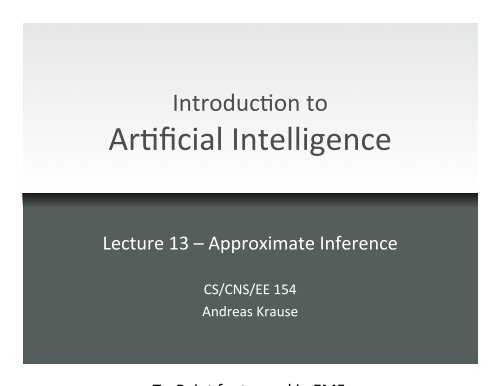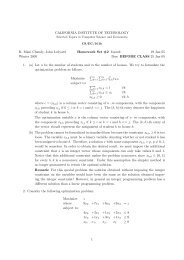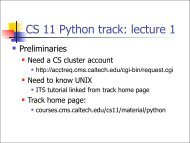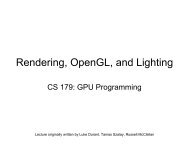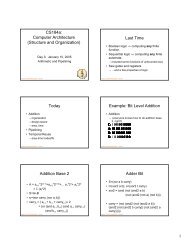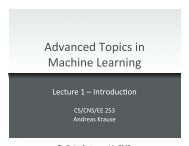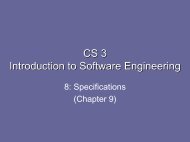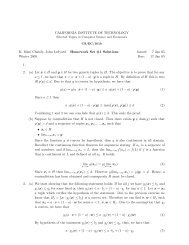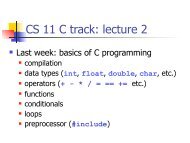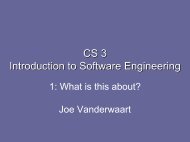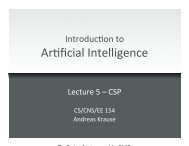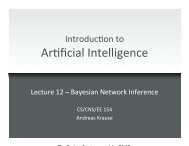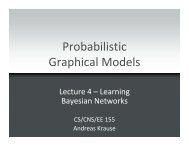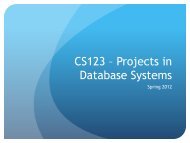You also want an ePaper? Increase the reach of your titles
YUMPU automatically turns print PDFs into web optimized ePapers that Google loves.
Introduc)on to Ar)ficial Intelligence Lecture 13 – Approximate Inference CS/CNS/EE 154 Andreas Krause
Bayesian networks ! Compact representa)on of distribu)ons over large number of variables ! (OQen) allows efficient exact <strong>inference</strong> (compu)ng marginals, etc.) HailFinder 56 vars ~ 3 states each JavaBayes applet ~10 26 terms > 10.000 years on Top supercomputers 2
Typical queries: Condi)onal distribu)on E B ! Compute distribu)on of some variables given values for others A J M 3
Typical queries: Maximiza)on ! MPE (Most probable explana)on): E A B Given values for some vars, compute most likely assignment to all remaining vars J M ! MAP (Maximum a posteriori): Compute most likely assignment to some variables 4
Hardness of <strong>inference</strong> for general BNs ! Compu)ng condi)onal distribu)ons: ! Exact solu)on: #P-‐complete ! NP-‐hard to obtain any nontrivial approxima)on ! Maximiza)on: ! MPE: NP-‐complete ! MAP: NP PP -‐complete ! Inference in general BNs is really hard 5
Inference ! Can exploit structure (condi)onal independence) to efficiently perform exact <strong>inference</strong> in many prac)cal situa)ons ! For BNs where exact <strong>inference</strong> is not possible, can use algorithms for <strong>approximate</strong> <strong>inference</strong> (later) 6
Variable elimina)on algorithm ! Given BN and Query P(X | E=e) ! Choose an ordering of X 1 ,…,X n ! Set up ini)al factors: f i = P(X i | Pa i ) ! For i =1:n, X i ∉ {X,E} ! Collect all factors f that include X i ! Generate new factor by marginalizing out X i ! Add g to set of factors ! Renormalize P(x,e) to get P(x | e) 7
Reusing computa)on ! OQen, want to compute condi)onal distribu)ons of many variables, for fixed observa)ons ! E.g., probability of Pits at different loca)ons given observed Breezes ! Repeatedly performing variable elimina)on is wasteful (many factors are recomputed) ! Need right data-‐structure to avoid recomputa)on Message passing on factor graphs 8
Factor graphs ! P(C,D,G,I,S,L) = P(C) P(I) P(D|C) P(G|D,I) P(S|I,G) P(L|S) C D G I S f 1 f 2 f 3 f 4 CD DIG IGS SL L C D G I S L 9
Factor graph ! A factor graph for a Bayesian network is a bipar)te graph consis)ng of ! Variables and ! Factors ! Each factor is associated with a subset of variables, and all CPDs of the Bayesian network have to be assigned to one of the factor nodes C D I f 1 f 2 f 3 f 4 CD DIG IGS SL G S L C D G I S L 10
Sum-‐product message passing on factor graphs ! Messages from node v to factor u ! Messages from factor u to node v f 1 f 2 f 3 f 4 CD DIG IGS SL C D G I S L 11
Example messages P(A)P(B|A) f 1 AB P(C|B) f 2 BC A B C 12
Belief propaga)on on polytrees ! Belief propaga)on (aka sum-‐product) is exact for polytree Bayesian networks ! Factor graph of polytree is a tree ! Choose one node as root ! Send messages from leaves to root, and from root to leaves ! AQer convergence: ! Thus: immediately have correct values for all marginals! 13
What if we have loops? ! Can s)ll apply belief propaga)on even if we have loops ! Just run it, close your eyes and hope for the best! ! Use approxima)on: ! In general, will not converge… ! Even if it converges, may converge to incorrect marginals… ! However, in prac)ce oQen s)ll useful! ! E.g., turbo-‐codes, etc. C D I ! “Loopy belief propaga)on” G S L 14
Behavior of Loopy BP X 1 1 True posterior .5 P(X 1 = 1) BP es)mate X 2 X 3 X 4 0 Itera)on # ! Loopy BP mul)plies same factors mul)ple )mes BP oQen overconfident 15
Does Loopy BP always converge? ! No! Can oscillate! ! Typically, oscilla)on the more severe the more “determinis)c” the poten)als Graphs from K. Murphy UAI ‘99 16
What about MPE queries? ! E.g.,: What’s the most likely assignment to the unobserved variables, given the observed ones? E B A J M ! Use max-‐product (same as sum-‐product/BP, but with max instead of sums!) 17
Max-‐product message passing on factor graphs ! Messages from nodes to factors ! Messages from factors to nodes f 1 f 2 f 3 f 4 CD DIG IGS SL C D G I S L 18
Sampling based <strong>inference</strong> ! So far: determinis)c <strong>inference</strong> techniques ! Variable elimina)on ! (Loopy) belief propaga)on ! Will now introduce stochas)c approxima)ons ! Algorithms that “randomize” to compute expecta)ons ! In contrast to the determinis)c methods, guaranteed to converge to right answer (if wait looong enough..) ! More exact, but slower than determinis)c variants 19
Compu)ng expecta)ons ! OQen, we’re not necessarily interested in compu)ng marginal distribu)ons, but certain expecta)ons: ! Moments (mean, variance, …) ! Event probabili)es 20
Sample approxima)ons of expecta)ons ! x 1 ,…,x N samples from RV X ! Law of large numbers: ! Hereby, the convergence is with probability 1 (almost sure convergence) ! Finite samples: 21
How many samples do we need? ! Hoeffding inequality Suppose f is bounded in [0,C]. Then ! Thus, probability of error decreases exponen)ally in N! ! Need to be able to draw samples from P 22
Sampling from a Bernoulli distribu)on ! Most random number generators produce (<strong>approximate</strong>ly) uniformly distributed random numbers ! How can we draw samples from X ~ Bernoulli(p)? 23
Sampling from a Mul)nomial ! X ~ Mult([µ 1 ,…,µ k ]) where µ i = P(X=i); ∑ i µ i = 1 µ 1 µ 2 µ 3 … µ k 0 1 ! Func)on g: [0,1]{1,…,k} assigns state g(x) to each x ! Draw sample from uniform distribu)on on [0,1] ! Return g -‐1 (x) 24
Forward sampling from a BN 25
Monte Carlo sampling from a BN ! Sort variables in topological ordering X 1 ,…,X n ! For i = 1 to n do ! Sample x i ~ P(X i | X 1 =x 1 , …, X i-‐1 =x i-‐1 ) ! Works even with loopy models! C D I G S L H J 26
Compu)ng probabili)es through sampling ! Want to es)mate probabili)es ! Draw N samples from BN C D I ! Marginals G L S ! Condi)onals H J 27
Rejec)on sampling ! Collect samples over all variables ! Throw away samples that disagree with x B ! Can be problema)c if P(X B = x B ) is rare event 28
Sample complexity for probability es)mates ! Absolute error: ! Rela)ve error: 29
Sampling from rare events ! Es)ma)ng condi)onal probabili)es P(X A | X B =x B ) using rejec)on sampling is hard! ! The more observa)ons, the unlikelier P(X B = x B ) becomes ! Want to directly sample from posterior distribu)on! 30
Gibbs sampling ! Start with ini)al assignment x (0) to all variables ! For t = 1 to ∞ do ! Set x (t) = x (t-‐1) ! For each variable X i ! Set v i = values of all x (t) except x i ! Sample x (t) i from P(X i | v i ) ! For large enough t, sampling distribu)on will be “close” to true posterior distribu)on! ! Key challenge: Compu)ng condi)onal distribu)ons P(X i | v i ) 31


